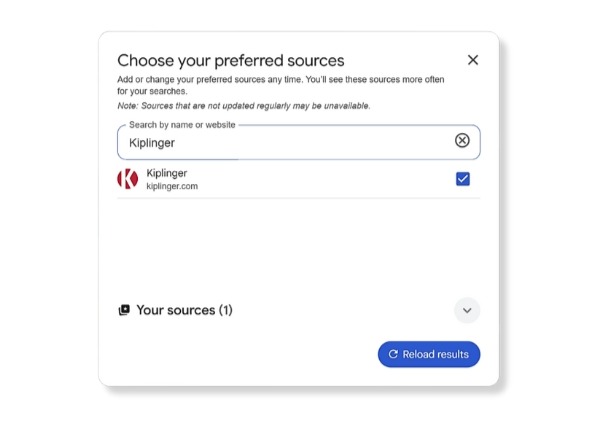How to Add Your Favorite News Sources to Google Top Stories
Google now lets you choose which outlets you want to see more often in Top Stories. Here's how to set your preferred sources in a few clicks.


Google is constantly upgrading how we get information, and one of its most popular features is the Top Stories section that appears above search results.
For years, users had little say in which outlets were featured, and it was all up to Google’s algorithm. That meant your Top Stories might show a mix of sources you trust alongside others you’d rather not read.
That’s changing. Google now gives you the ability to choose which outlets you want to prioritize. Whether you rely on Kiplinger for personal finance insights or the Associated Press for breaking news, you can tell Google directly: “Show me more of this.”
From just $107.88 $24.99 for Kiplinger Personal Finance
Become a smarter, better informed investor. Subscribe from just $107.88 $24.99, plus get up to 4 Special Issues

Sign up for Kiplinger’s Free Newsletters
Profit and prosper with the best of expert advice on investing, taxes, retirement, personal finance and more - straight to your e-mail.
Profit and prosper with the best of expert advice - straight to your e-mail.
In a few clicks, you can customize your feed so it reflects your reading preferences instead of a generic mix.
What are Google Top Stories?
Top Stories is the box of headlines you often see at the top of a Google results page when you search for newsworthy events, breaking developments or trending topics. Powered by Google News, it gives you quick access to headlines without having to open a separate app.
The feature is popular because it’s fast and convenient — you don’t have to dig for your favorite sources to stay current. The drawback, until now, was that you couldn’t control the mix of outlets.
For example, you might prefer Kiplinger’s finance reporting but find that it only shows up sporadically. With the new update, you no longer have to wait for the algorithm to decide. Instead, you can tell Google to prioritize Kiplinger, or any other outlet you value.
How to add a preferred source in the SERP

The most seamless way to add a preferred source is directly in the search engine results page (SERP). Here’s how it works:
- Search for a topic. Let’s say you Google “best retirement strategies” and see articles from a variety of news publications the Top Stories carousel (it should be the first section you see in the results, right below the search bar).
- Look for the icon. Near the headline ‘Top Stories’, you’ll see an option (a star or “more from this source” label).
- Click to set your preference. You can search for and select more than one publication. Once you’ve made your selections, Google takes note and increases the likelihood of showing you those content sources the next time you search for newsworthy topics.
This method is perfect if you discover new outlets while browsing. You don’t have to leave the page or go into settings, and it takes only a second. Think of it as giving Google a “thumbs up” for the sources you want.
How to add a preferred source using Google’s settings

For those who prefer a one-and-done approach, Google has created a central settings page in which you can add and manage all your preferred sources. Here’s how it works:
- Visit Set Your Preferred Sources on Google.
- In the search box, type in the name of the publication you want to follow. You could add Kiplinger, ABC, PCMag, Forbes, even your favorite lifestyle or regional outlet.
- Once added, the source becomes part of your preference list. Google will now weigh those outlets more heavily in the Top Stories carousel whenever you’re searching for related topics.
This approach is especially handy if you already know which publications you want to see more often. Instead of waiting to encounter them in a SERP, you can proactively build your list in one sitting.
The benefits of setting your preferred sources
Being able to customize which outlets show up in Google’s Top Stories is more than just a convenience. It’s a way to take control of how you consume news.
Instead of relying solely on Google’s algorithm, you now have a direct say in what appears at the top of your search results. That means you can make sure you’re seeing coverage from the outlets you trust most.
Over time, this can save you from scrolling past articles you don’t care for, while helping you stay up to date on the subjects you follow most closely.
In a world where headlines often conflict depending on who’s writing them, prioritizing your preferred sources means you’ll hear from outlets you already consider credible.
Related Content:
Profit and prosper with the best of Kiplinger's advice on investing, taxes, retirement, personal finance and much more. Delivered daily. Enter your email in the box and click Sign Me Up.

Choncé is a personal finance freelance writer who enjoys writing about eCommerce, savings, banking, credit cards, and insurance. Having a background in journalism, she decided to dive deep into the world of content writing in 2013 after noticing many publications transitioning to digital formats. She has more than 10 years of experience writing content and graduated from Northern Illinois University.
-
 4 Great Tools to DIY Your Own Financial Plan
4 Great Tools to DIY Your Own Financial PlanSmart Savings Several tools picked out by Kiplinger that DIYers can use to make their own financial plan.
-
 The 7-Month Deadline That Sets Your Lifetime Medicare Premiums
The 7-Month Deadline That Sets Your Lifetime Medicare PremiumsUnderstanding Medicare enrollment is crucial, as missing deadlines can lead to permanent late enrollment penalties and gaps in coverage.
-
 Retirees Living in Portugal: You Need a Post-NHR Tax Strategy
Retirees Living in Portugal: You Need a Post-NHR Tax StrategyWhen your 10-year Non-Habitual Resident tax break ends, you could see your tax rate soar. Take steps to plan for this change well before the NHR window closes.
-
 4 Great Tools to DIY Your Own Financial Plan
4 Great Tools to DIY Your Own Financial PlanSmart Savings Several tools picked out by Kiplinger that DIYers can use to make their own financial plan.
-
 The 7-Month Deadline That Determines Your Lifetime Medicare Premiums
The 7-Month Deadline That Determines Your Lifetime Medicare PremiumsUnderstanding Medicare enrollment is crucial, as missing deadlines can lead to permanent late enrollment penalties and gaps in coverage.
-
 Should You Renew Your CD?
Should You Renew Your CD?With rate cuts impacting earnings, we examine if now is a wise time to renew CDs.
-
 Where to Store Your Cash in 2026
Where to Store Your Cash in 2026Set yourself up for success with these strategies.
-
 I'm a Financial Adviser: The Fed's Rate Cuts Could Have Impacts You Might Not Anticipate
I'm a Financial Adviser: The Fed's Rate Cuts Could Have Impacts You Might Not AnticipateUnderstanding how lower interest rates could impact your wallet can help you determine the right financial moves to make.
-
 My Teen Crashed His Car, and Now Our Insurance Has Tripled. What Now?
My Teen Crashed His Car, and Now Our Insurance Has Tripled. What Now?Dealing with the costly aftermath of a teen car accident is stressful. Here are your options for navigating it.
-
 My First $1 Million: Retired In-House Corporate Lawyer, 74, Midwest
My First $1 Million: Retired In-House Corporate Lawyer, 74, MidwestEver wonder how someone who's made a million dollars or more did it? Kiplinger's My First $1 Million series uncovers the answers.
-
 I'm an Insurance Pro: Going Without Life Insurance Is Like Driving Without a Seat Belt Because You Don't Plan to Crash
I'm an Insurance Pro: Going Without Life Insurance Is Like Driving Without a Seat Belt Because You Don't Plan to CrashLife insurance is that boring-but-crucial thing you really need to get now so that your family doesn't have to launch a GoFundMe when you're gone.